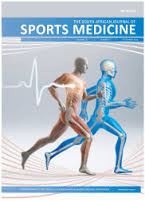End-to-end SARS-CoV-2 transmission risks in sport: Current evidence and practical recommendations
SARS-CoV-2 transmission risks in sport
DOI:
https://doi.org/10.17159/2078-516X/2021/v33i1a11210Abstract
The coronavirus disease 2019 (COVID-19) pandemic has caused disruption to professional and recreational sports across the world. The SARS-CoV-2 virus can be transmitted by relatively large respiratory droplets that behave ballistically, and exhaled aerosol droplets, which potentially pose a greater risk. This review provides a summary of end-to-end SARS-CoV-2 transmission risk factors for sport and an overview of transmission mechanisms to be considered by all stakeholders. The risk of SARS-CoV-2 transmission is greatest indoors, and primarily influenced by the ventilation of the environment and the close proximity of individuals. The SARS-CoV-2 transmission risks outdoors, e.g. via water, and from fomites, appear less than initially thought. Mitigation strategies include good end-to-end scenario planning of activities to optimise physical distancing, face mask wearing and hygiene practice of individuals, the environment and equipment. The identification and removal of infectious individuals should be undertaken by means of the taking of temperature and COVID-19 symptom screening, and the use of diagnostic monitoring tests to identify asymptomatic individuals. Using adequate video footage, data from proximity technology and subject interviews, the identification and isolation of ‘close contacts’ should also be undertaken to limit SARS-CoV-2 transmission within sporting environments and into the wider community. Sports should aim to undertake activities outdoors where possible, given the lower SARS-CoV-2 transmission risk, in comparison to indoor environments.
Downloads
Downloads
Published
Issue
Section
License
The South African Journal of Sports Medicine reserves copyright of the material published. The work is licensed under a Creative Commons Attribution 4.0 (CC BY 4.0) International License. Material submitted for publication in the South African Journal of Sports Medicine is accepted provided it has not been published elsewhere. The South African Journal of Sports Medicine does not hold itself responsible for statements made by the authors.
How to Cite
- Abstract 1357
- PDF 669
Metrics

- Citations
- Citation Indexes: 2
- Usage
- Full Text Views: 100
- Abstract Views: 4
- Captures
- Readers: 28





.png)